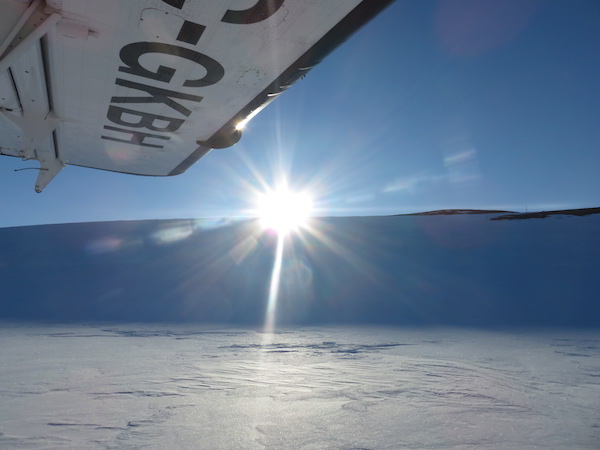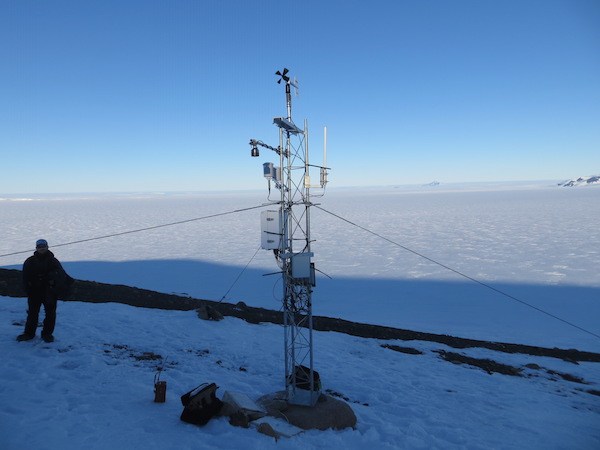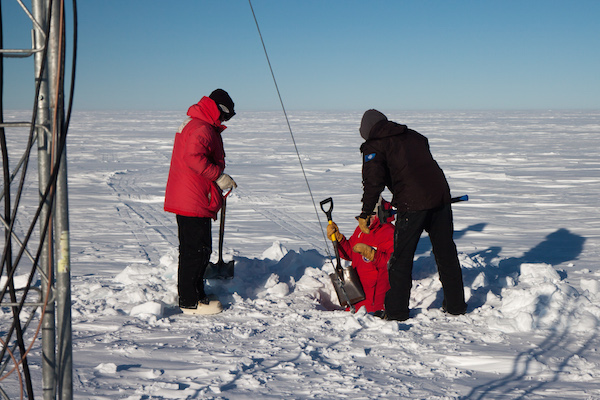Dec 14 – Monday
Mark and I were hoping to be flying off continent, back to Christchurch, and heading home today. Instead, we are still at WAIS. The weather and flight schedules have not cooperated with us, so our new off-ice departure date is now Thursday 17 December.
We made two more attempts to fly back to McMurdo, this time via Twin Otter instead of LC-130, on this past Saturday and Sunday. There are also 3 other people from WAIS who want to get back to McMurdo. Since the Otter is a smaller aircraft, it requires fuel stops along the way to McMurdo, whereas the LC-130 can make a non-stop flight. This has two implications: the Otter trip is a long one, and weather needs to be good at 4 locations instead of 2 (we were planning to stop at Byrd Camp to pick up a passenger along the way, then stop at Siple Dome Camp to refuel, then land in McMurdo).
On both days, the weather in West Antarctica (WAIS, Byrd Camp, Siple Dome Camp) was gorgeous: mostly clear skies and calm winds. Unfortunately, the weather was poor in McMurdo, with low clouds, fog, and low visibility.
On Saturday morning, Troy, the Otter pilot, decided that we wouldn’t be going to McMurdo due to the poor weather. Given the good weather in the region, including at the site of a new station install, Mark and I decided to take the opportunity. We installed Austin AWS. West Antarctica now has a new data point!
This was both mine and Mark’s first new station install. (I was along for the install of White Island AWS a few years ago, but the Rigger crew did most of the work with the guy wires because that station is on rock. Austin AWS is on snow.) We had one boondoggler with us, Catherine Dudley (WAIS medic), and she and the pilots were excellent helpers for the entire installation.

We laid out the equipment and gear for the new installation. That’s Catherine on the right. (Photo credit: Mark)
Here’s the order of operations for installing a new AWS:
0) Preassemble anything you can. The guy wires were attached to one tower section before we left; one extends from each of the three tower poles. The turnbuckles were also attached to the dead men prior to departure.
1) We asked Troy if he could use the plane to make ski marks in the snow that are oriented in the true North-South direction. He did this, as well as parked the Otter in said orientation. This is necessary for the proper installation of the anemometer, as one part of it needs to be pointed true South.
2) Connect the two tower sections (one 10 feet, one 7 feet) together on the ground.
3) Dig a hole, approximately 2 feet deep since we didn’t have a baseboard, into which we can put the tower.
4) Install as much instrumentation on the tower as is practical, while the tower is slightly lifted off the ground (we propped it up on a couple cases to make the installing easier). We installed the anemometer, Argos antenna, upper temperature, relative humidity, solar panel, enclosure, and lower temperature.

With the main hole dug and the towers connected, we assembled all of the instrumentation, save the ADG and pyranometer boom. From left: Mark, Troy, John. (Photo credit: Catherine)
5) Lift up the tower into the hole. This took all 5 of us to accomplish.
6) Orient the tower to have one face point North-South. This makes aligning the anemometer that much easier. One done, fill in the hole.
7) Extend the guy wires out and determine where to bury the dead men. Then dig holes for the 3 dead men, approximately 4 feet deep.
8) Attach the guy wires to the dead men, then bury the dead men in the holes, making sure the tower is level and plumb all the while.
9) Once everything is secure, the tower is secured and everything else can proceed as normal.

A new AWS! A new data point in Antarctica! And as you may be able to tell, the visibility decreased drastically by the end of our visit as the winds had increased. (Photo credit: Mark)
We felt pretty good after we completed this install. Any work that we can do now is less work that Lee and Carol need to worry about when they come to WAIS. While we have the Otter to ourselves, we might as well take advantage of it.
Yesterday, Sunday, we tried the same thing as Saturday in taking the Otter back to McMurdo. Once again, with great weather in West Antarctica, McMurdo was the limiting factor. We were on a weather hold until 10:30 am, when we got an updated weather forecast for the evening in McMurdo. It initially called for some clearing, so Troy decided that we should go for it. Everyone loaded all their gear on the Otter, and we took off at 11:45 am. Ten minutes in the air, we boomeranged. Troy had gotten an updated observation from McMurdo where fog was rolling into the region quickly. Troy made the call that rather than being forced to camp near McMurdo, we would go back to WAIS. It was the right call, but it was a bummer because we were so close to making our scheduled departure date but now need to push it back.
The consolation, once again, was that Mark and I were able to fly to another AWS, this time back to Evans Knoll AWS. We reinstalled the enclosure that we had removed a few days back, complete with a functioning pressure sensor, and installed a new solar panel.
We took 3 boondogglers with us: Kristen (chef), Anne (camp supervisor) and Kevin (mechanic). On our way to Evans Knoll, we took the scenic route and saw some amazing images of icebergs, islands, penguins and seals. Evans Knoll is near Pine Island Bay and Pine Island Glacier, an area where the ice is breaking up rapidly. Also, at Evans Knoll itself, the winds were very calm (sometimes at 0!) which was a huge improvement from the 30 knot winds we encountered on our first visit.

The sun was peaking over the hill we needed to climb to get to Evans Knoll AWS, on the right and at the crest of the hill.

Evans Knoll AWS with the enclosure reinstalled and a new solar panel installed (on the opposite side of the tower).
The latest on leaving WAIS is that our LC-130 flight (a backup mission) for today was cancelled because the primary mission went to Christchurch (no surprise there). I think we are on a primary mission for tomorrow, but we won’t find that out exactly until later tonight.






